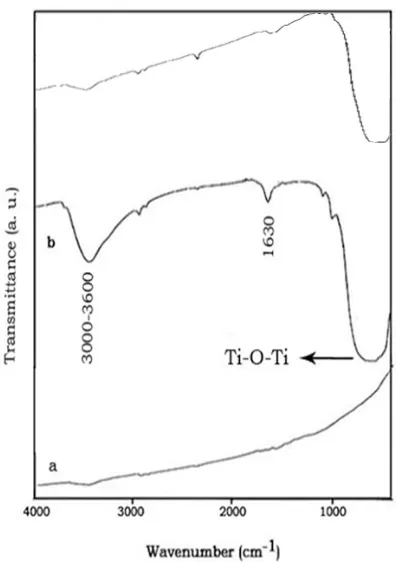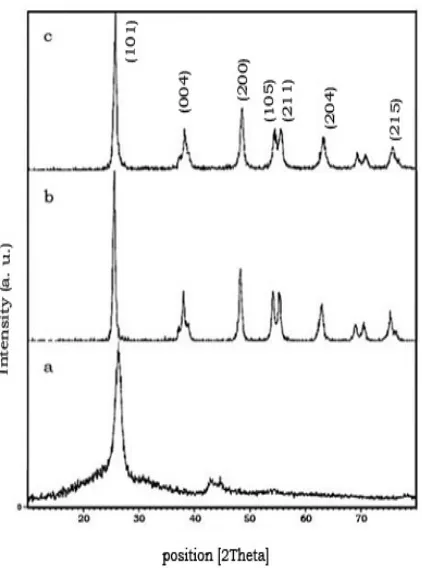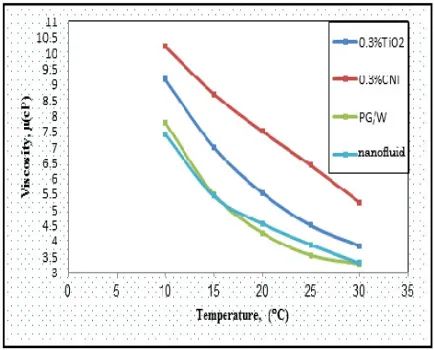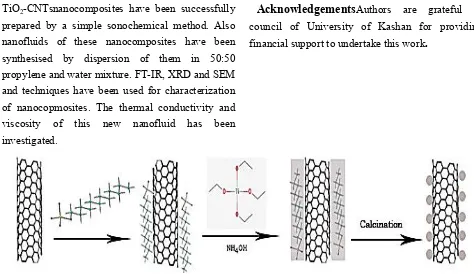Synthesis and Characterization of TiO
2-CNTs Nanocomposite and
Investigation of Viscosity and Thermal Conductivity of a New
Nanofluid
Elahe Khosravifard
a, Masoud Salavati-Niasari*
,b, Mahnaz Dadkhah
Cand
Gholamhossein Sodeifian
aa Department of Chemical Engineering, Faculty of Engineering, University of Kashan,Kashan, P. O. Box. 87317 51167, I. R. Iran
bInstitute of Nano Science and Nano Technology, University of Kashan, Kashan, P. O. Box. 87317-51167, I. R. Iran
c Department of Inorganic Chemistry, Faculty of Chemistry, University of Kashan,Kashan, P. O. Box. 87317 51167, I. R. Iran
Abstract
Nanofluids are kinds of fluids engineered by dispersing nanoparticles in base fluids, a new challenge for thermal sciences provided by nanotechnology. Due to their excellent characteristics, nanofluids find wide applications in enhancing heat transfer. This paper presents synthesis and characterization of TiO2-CNTs nanocomposites by sonochemical method and investigation of some properties of TiO2-CNTs nanocomposite suspended in 50:50 (by weight) propylene glycol and water mixture as a new nanofluid.
2012 JNS All rights reserved Article history:
Received 23/5/2012 Accepted 11/8/2012 Published online 1/9/2012
Keywords:
TiO2-CNTs nanocomposite,
Nanofluid,
Thermal conductivity, Viscosity
*Corresponding author: E-mail address:
Salavati@kashanu.ac.ir Phone: +98 361 591 2383 Fax: +98 361 5552935
1. Introduction
The concept of nanofluid is not new as in 1857 Michael Faraday first reported the study on the synthesis and colours of colloidal gold, but it was possible to put it into practice only after the tremendous development of nanotechnologies
biological nanofluid where different nanoparticles (at molecular level) accomplish different functions, and functional components actively respond to their local environment. According to the types of liquids (organic and inorganic) and kinds of nanoparticles, one can get different types of nanofluids like process extraction nanofluids, environmental (pollution-controlling nanofluids), bio, and pharmaceutical nanofluids. Some properties such as: Stability, Small concentration, Newtonian behavior and abnormal enhancement of thermal conductivity, provided necessary force to begin research in nanofluids, with the expectation that these fluids will play an important role in developing the next generation of cooling technology. Nanofluids have novel properties that make them potentially useful in many applications in heat transfer, including microelectronics, fuel cells, pharmaceutical processes, and hybrid-powered engines, engine cooling/vehicle thermal management, domestic refrigerator, chillers, heat exchanger, nuclear reactor coolant, in grinding, machining, in spacetechnology, defence and ships, and in boiler flue gas temperature reduction.[3,4].The nanoparticles used in nanofluids are typically made of metals, oxides, carbides, or carbon nanotubes. The first materials tried for nanofluids were oxide particles, primarily because they were easy to produce and chemically stable in solution[5]. Thereafter, carbon nanotubes were used to produce nanofluids and greater enhancement of thermal conductivity observed for CNTs nanofluids compared with oxide nanofluids[6,7]. In this study We have reported the preparation of a new nanofluid including of nanocomposites instead of nanoparticles dispersed in 50:50 (by weight)
propylene glycol and water mixture, for the first time.
2 Experimental
2.1 Materials and characterization
All chemicals were of reagent grade and used as received. XRD patterns were recorded by a Rigaku D-max C III, X-ray diffractometer using Ni-filtered Cu Kα radiation. Elemental analysis was obtained by Carlo ERBA Model EA 1108 analyzer. Scanning electron microscopy (SEM) images were obtained on Philips XL-30ESEM equipped with an energy dispersive X-ray spectroscopy. Fourier transform infrared (FT-IR) spectra were recorded on Shimadzu Varian 4300 spectrophotometer in KBr pellets.
in an oven under ambient condition, maintaining at this temperature for 30 min.
2.3. Synthesis of nanofluid
In our experiments, we used TiO2-CNTs nanocomposites were dispersed in a 50:50 (in weight) propylene glycol and water mixture for the nanofluid mixture was then stirred and agitated thoroughly for 30 min. with an ultrasonic agitator similar to the preparation of nanofluids by He et al. [9].
3. Results and discussion
3.1. Characterization of nanocomposite
FT-IR spectra were recorded and are shown in Fig. 1.In Fig. 1a, which is dedicated to carbon nanotubes, there are no functional groups. As shown in Fig. 1b,the absorption around 1630 cm−1 is assigned to the bending vibration of
adsorbed water molecules. The absorption from 3000 to 3600 cm−1 is due to the stretching vibration of the hydrogen-bonded OH groups of the adsorbed water. The broad band below 950 cm−1 in the FT–IR spectra of all the TiO
2 samples belongs to the characteristic vibrations of the inorganic Ti–O–Ti network[10].
XRD pattern of CNTs, TiO2 and TiO2-CNTs nanocomposites is shown in Fig. 2. The two features peaks of CNTs at 2θ position of 26.0◦ and 43.4◦, can be identified in Fig. 2a. From XRD
pattern of TiO2 (Fig. 2b), it can be observed, the anatase constitutes the major crystal form in the pure TiO2 (JCPDS card no: 04-0477) sample.
Fig.2c presents the XRD results of the TiO2 -CNTs nanocomposites that were prepared by the sol–gel process. The XRD patterns show that only anatase phase TiO2 can be identified in the nanocomposite; the rutile phase of TiO2 was not observed. These results imply that the
TiO2nanocrystalline structure was retained with CNTs in theTiO2 matrix. Furthermore, peaks at 2θ position of 26.0◦ and 43.4◦, which are the
characteristics of carbon nanotubes, were not observed in the XRD patterns of nanocomposites. The interpretation of this phenomenon was that the main peak of the CNTs at 26.0◦ might overlap with the main peak of anatase TiO2 crystallites at 25.4◦ since these two peaks are very close.
Moreover, the TiO2 crystallinity is much higher than that of the CNTs, which could cause the TiO2 to shield the MWCNTs peaks [11]. It is therefore quite difficult to identify CNT characteristic peaks in XRD patterns of the nanocomposite.
Fig. 1. FT-IR spectra of a) carbon nanotubes b) TiO2 and c) TiO2-CNTs nanocomposites.
3.2. Investigation of thermal conductivity of TiO2-CNTs nanofluids
Nusselt number is a parameter that the heat transfer characteristic of a flowing fluid can be specified by it, which takes into account the Prandtl number including thermal conductivity. Thus, a first evaluation of the heat transfer potential of a nanofluid is to measure its thermal conductivity. The thermal conductivity of nanofluids is much improved when compared with usual fluids.
Fig. 2. XRD pattern of a) CNTs, b) TiO2 and c) TiO2
-CNTs nanocomposites.
The thermal conductivity of TiO2-CNTs nanofluids was measured using H471 apparatus. Measurements were taken for all samples of nanofluid at different temperature. From Fig. 4, the thermal conductivity of the nanofluid samples
first increases intensely with temperature and after 28 C it increases on-linearly with temperature slightly.
Fig. 3. SEM images of a) TiO2, b) CNTs and c) TiO2
The thermal conductivity increases with increasing temperature, as well as in all studies of this relationship have been rising. But nanotubes, and titanium oxide nanocomposites increased markedly in the case of nonlinear nanotubes and nanocomposites can be pointed to the important role of interactions that lead to behavior change in nanofluids it is linear to nonlinear behavior.
Fig. 4. Enhancement in the thermal conductivity of samples with temperature.
Fig. 5. Comparison of thermal conductivity of different samples
3.3. Investigation of viscosity of TiO2-CNTs nanofluids
Determining the viscosity of the nanofluid is essential to establishing adequate pumping power as well as the convective heat transfer coefficient, as the Prandtl and Reynolds numbers (functions of viscosity) will be influenced. Experimental data for the effective viscosity of aqueous nanofluids is limited to certain nanoparticles, such as Al2O3[12–15], CuO[14,16], TiO2[12] and MWCNT [17]
.
Viscosity generally increases with increasing temperature due to Brownian motion components, and decreases the change in fluid viscosity with temperature is more severe. The increase in viscosity due to the addition of nanoparticles to the base fluid temperature dependency of nanofluid increases within creasing concentration. Mechanism of change of viscosity with temperature isn't very different from the base fluid that such behaviors also visible in the published studies
Fig. 6. Experimental values of viscosity for same concentrations of samples respect to temperature
TiO2-CNTsnanocomposites have been successfully prepared by a simple sonochemical method. Also nanofluids of these nanocomposites have been synthesised by dispersion of them in 50:50 propylene and water mixture. FT-IR, XRD and SEM and techniques have been used for characterization of nanocopmosites. The thermal conductivity and viscosity of this new nanofluid has been investigated.
Acknowledgements
Authors are grateful to council of University of Kashan for providing financial support to undertake this work.Fig. 7. Schematic for synthesis of nanocomposite.
References
[1]. S, Choi. In Development and applications of non-newtonian flows, edited by D.A. Siginer and H.P. Wang, New York: ASME, (1995), 99-105. [2] J.A. Eastman, S.U.S. Choi, S. Li, W. Yu, L.J. Applied Physics Letters 78 (6) (2001) 718–720. [3] F.C. Mc Quiston, J.D. Parker, J.D. Spitler, Heating Ventilating and Air-Conditioning, John Wiley & Sons Inc., New York, 2000.
[4] ASHRAE Handbook 1985 Fundamentals, American Society of Heating, Refrigerating and Air-Conditioning Engineers Inc., Atlanta, 1985. [5] S. Lee, S. U. S. Choi, S. Li, and J. A. Eastman, Transactions of ASME, Journal of Heat Transfer. 121 (1999) 280–289.
[6] J. A. Eastman, S. U. S. Choi, S. Li, W. Yu, and L. J. Thompson, Applied Physics Letters, 78, (6) (2001) 718– 720,.
[7] S.U.S. Choi, Z.G. Zhang, W. Yu, F. E. Lockwood, and E. A. Grulke, Applied Physics Letters, (79) (2001) 2252– 2254,
[8] B. Gao, G.Z. Chen, G. Li Puma, Appl. Catal. B: Environ. 89 (2009) 503-509.
[9] Y. He, Y. Jin, H. Chen, Y. Ding, D. Cang, H. Lu, Int. J. of Heat and Mass Transfer 50 (2007) 2272– 2281.
[10] PD. Cozzoli, A. Kornowski, H. Weller, J. of Am. Chem. Soc. (125) (2003) 14539–14548.
[11] S. Lee and W M. Sigmund, chem. Communi. (2003) 780-781.
[12] B.C. Pak, Y.L. Cho. Heat Transfer 11 (2) (1998) 151–170.
[13] S.K. Das, N. Putra, W. Roetzel, Int. J. Heat Mass Transfer 46 (5) (2003) 851–862.
[15] S.Z. Heris, S.G. Etemad, M.N. Esfahany, Int. Commun. Heat Mass Transfer 33 (4) (2006) 529– 535.



